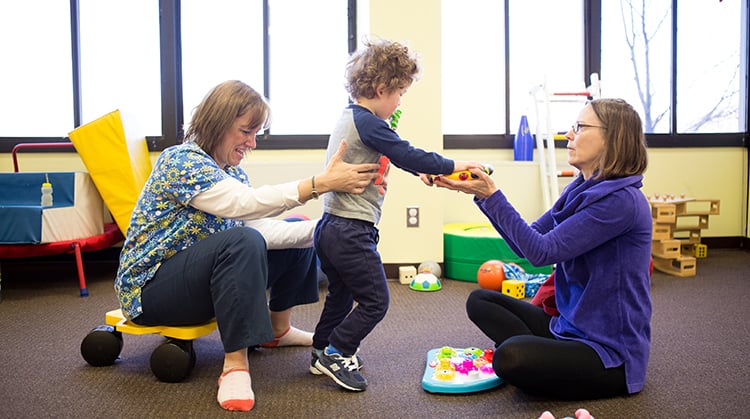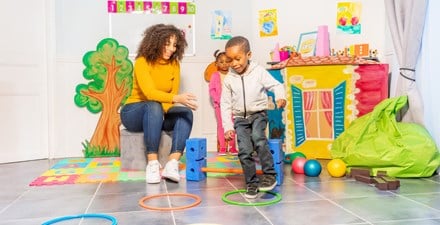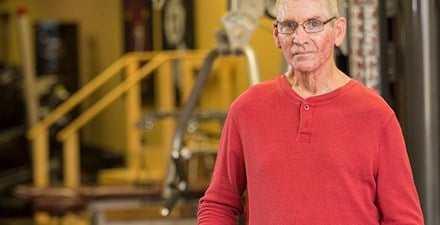Physical Therapy Guide to Cerebral Palsy
Cerebral palsy is a term that describes a group of disorders affecting the normal development of movement and posture. CP is caused by injury to the brain that occurs before, during, or up to two years after birth. These injuries can include infection, stroke, trauma, or the loss of oxygen. Damage to the brain does not get worse after the initial injury. However, the ability to do day-to-day activities that are affected by the injury can worsen as a person grows.
People with CP may have trouble seeing, hearing, feeling touch, thinking, or communicating. They also may have seizures. Difficulties can range from mild to severe.
CP affects approximately four infants in every 1,000 born in the US The number of children diagnosed with CP has grown in recent years. This increase is a result of the improved survival rate of premature babies and those born with low birth weight. The average life expectancy of adults with CP has increased as well. People with CP can benefit from physical therapy during all the stages of their lives.
Physical therapists are experts in helping people with CP improve their physical functions. They help them stay active and healthy, and perform daily tasks like walking, using a wheelchair, and moving from a wheelchair to and from a bathtub, bed, or car. Physical therapists also can help children and families get equipment to support someone with CP.
Physical therapists are movement experts. They improve quality of life through hands-on care, patient education, and prescribed movement. You can contact a physical therapist directly for an evaluation. To find a physical therapist in your area, visit Find a PT.
What Is Cerebral Palsy?
Cerebral palsy is a broad term. It is caused by an injury to the developing brain and describes the effects on the development of motor skills (movements). There are several types of CP. These types are named based on the type of movement problem and the areas of the body affected. They are:
- Spastic CP: Muscle spasms that can occur with movement.
- Ataxic CP: Problems with balance and coordination throughout the body.
- Dyskinetic CP: Unpredictable changes in muscle tone and movement that creates an unstable posture.
- Mixed CP: A combination of the above movement problems (spastic, dyskinetic, or ataxic).
- Quadriplegia: CP that affects both arms and legs, the neck, and the trunk.
- Diplegia: Affects either both legs (the most common form) or both arms (less common).
- Hemiplegia: Impacts just one side of the body.
- Monoplegia: Affects just one limb. This type is rare.
Signs and Symptoms
Symptoms of CP differ from one person to the next. They can appear as early as when a baby is just a few months old. Usually, parents notice symptoms before a child is two years old. Early symptoms may include:
- Inability to hold the head up as well as other babies of the same age.
- Difficulty reaching with the arms.
- Trouble rolling, sitting, crawling, or walking.
Other symptoms of CP related to movement can include:
- Tight muscles that worsen with stress, illness, and time.
- Tight joints that do not bend or stretch all the way. This symptom occurs especially in the hands, elbows, hips, knees, or ankles.
- Muscle weakness, or a decline in movements that the child had already been performing.
- Slower movement compared with other children.
- Lesser movement of the legs, arms, trunk, or neck.
- Lack of coordination.
- "Floppy" muscles, especially in the neck or trunk.
- Muscle tremors.
Other symptoms of CP can include:
- Trouble speaking or being understood.
- Learning disorders (even though the child has normal intelligence).
- Vision problems.
- Hearing problems.
- Seizures.
- Joint pain that is often caused by tight muscles or poor posture.
- Decreased mouth-muscle strength or coordination. This leads to problems eating and/or increased drooling.
- Constipation.
- Difficulty holding urine.
- Slower-than-normal growth.
How Is It Diagnosed?
A child's doctor may notice a delay in movement and refer the child to a physical therapist. If a child is seeing a physical therapist but does not have a diagnosis, the physical therapist may recommend that the parents contact their child's pediatrician.
If CP is suspected, your child's physical therapist will conduct a medical history. They will ask questions about the mother's pregnancy, the birth, and the general health of the child. They also will ask about your concerns. As part of a thorough evaluation, your physical therapist will:
- Observe the child in different positions to assess movement patterns.
- Conduct a hands-on assessment of the child's muscle tone, strength, flexibility, and reflexes.
- Determine how well the child can sit, stand, or grasp objects (developmental milestones).
Your child's physical therapist will work together with your child's doctor, who may order further tests. These could include blood work or imaging scans (MRI or CT) to reach a final diagnosis.
How Can a Physical Therapist Help?
A physical therapist is a valuable partner in the health and fitness of anyone who has CP. Physical therapists help people with CP gain strength and movement to function at their best through all the stages of life.
Physical therapists provide care at different stages in each person's development. They tailor care to the unique needs of each individual. Physical therapists work together with other health care providers to address the needs as treatment priorities change. Other health care providers who may work with your physical therapist include speech/language pathologists or occupational therapists.
Physical Therapy in the Early Years: Birth to Age 4
Physical therapists help caregivers support their child's movement development. They provide hands-on training for positioning, movement, feeding, play, and self-calming. Your physical therapist also will suggest changes at home to encourage movement development as well as communication, hearing, vision, and play skills. It is through play that young children learn many skills. Your child's physical therapist will develop an individual program of fun play activities that match your child's specific needs. The goals of the program are to improve strength, movement, and function. At this age, children usually receive physical therapy at home, in a day care center, or an outpatient clinic. Your physical therapist will work with you to modify the treatment program as your child develops.
Physical Therapy in the School Years: Ages 5 to 18
Physical therapists train caregivers to help a child with CP achieve functional goals. Physical therapy promotes the highest quality of life through all stages of development. The treatment plan and goals will change as your child ages. Preschool and school bring challenges for your child to move within new settings each year. At this stage, children experience growth spurts and require adjustments to physical therapy and any equipment used to help the child. A child may receive physical therapy at the school, in the community, or both, depending on their needs. School-based physical therapy focuses on making changes to give your child the best possible learning environment.
Your child's PT will encourage mobility and fitness. They also will help your child manage muscle and joint pain. Physical therapists recommend braces and other helpful equipment to maintain health and function. Physical therapy also teaches parents and helps people with CP develop strategies to address self-care, maintain daily routines, and be social and active. This will help you and your child plan for school and future careers.
Physical therapy for adolescents with CP focuses on preventing posture problems and joint mobility limitations. Adolescence is the age and stage of life to form lifelong healthy habits. Developing a personal fitness program can improve the health and function of people with CP for the rest of their lives. Children with CP are at a higher risk for not exercising and getting enough activity. Physical inactivity can lead to weight issues and medical problems. These issues can have a big impact on the quality of life for the child and their caregivers. Physical therapists are skilled in developing individual exercise programs. They consider each person's interests, strengths, and abilities. A physical therapist might recommend sports such as bowling, swimming, cycling, volleyball, tennis, or basketball to promote physical fitness and participating in social events with peers.
Physical Therapy in Adulthood: Age 18+
Many individuals with CP live highly functional lives as adults. They often enjoy careers and families. Physical therapy for adults with CP often focuses on:
- Pain management.
- Energy conservation.
- Use of helpful adaptive equipment.
- Environmental changes to promote independence at work and at home.
Physical therapists can form long-term relationships with their clients to help manage concerns such as these. Adults with CP often have muscle and joint pain in adulthood. Physical therapists can prescribe exercise routines that enable them to stay strong and reduce joint issues. For example, aquatic therapy can benefit adults with CP.
Physical therapists are skilled in helping people with CP in all of these areas. They partner with them and their caregivers to address their individual goals for realistic, positive outcomes.
What Kind of Physical Therapist Do I Need?
All physical therapists are prepared through education and experience to treat patients with cerebral palsy. However, you may want to consider:
- A physical therapist who has experience treating people with CP.
- A physical therapist who focuses on treating infants and children.
- A physical therapist who is a board-certified clinical specialist or who has completed training in pediatric or neurologic physical therapy. This physical therapist has advanced knowledge, experience, and skills.
You can find physical therapists who have these and other credentials by using Find a PT, the online tool built by the American Physical Therapy Association. This tool will help you search for physical therapists with specific clinical expertise in your local area.
General tips when you're looking for a physical therapist (or any other health care provider):
- Get recommendations from family, friends, or other health care providers.
- When you contact a physical therapy clinic for an appointment, ask about the physical therapists' experience in helping people who have cerebral palsy.
- Be prepared to describe symptoms in as much detail as possible, identify what makes the symptoms worse or better, and discuss your goals.
The American Physical Therapy Association believes that consumers should have access to information that could help them make health care decisions and also prepare them for a visit with their health care provider.
The following articles provide some of the best scientific evidence related to physical therapy treatment of cerebral palsy. The articles report recent research and give an overview of the standards of practice both in the US and internationally. The article titles are linked either to a PubMed* abstract of the article or to free access of the full article, so that you can read it or print out a copy to bring with you to your health care provider.
Yeargin-Allsopp M, Van Naarden Braun K, Doernberg NS, Benedict RE, Kirby RS, Durkin MS. Prevalence of cerebral palsy in 8-year-old children in three areas of the United States in 2002: a multisite collaboration. Pediatrics. 2008;121;547–554. Article Summary in PubMed.
Horsman M, Suto M, Dudgeon B, Harris SR. Growing older with cerebral palsy: insiders’ perspectives. Pediatr Phys Ther. 2010;22:296–303. Article Summary in PubMed.
Ustad T, Sorsdahl AB, Ljunggren AE. Effects of intensive physiotherapy in infants newly diagnosed with cerebral palsy. Pediatr Phys Ther. 2009;21:140–149. Article Summary in PubMed.
Dumas HM, Watson K, Fragala-Pinkham MA, et al. Using cognitive interviewing for test items to assess physical function in children with cerebral palsy. Pediatr Phys Ther. 2008;20:356–362. Article Summary in PubMed.
Mockford M, Caulton JM. Systematic review of progressive strength training in children and adolescents with cerebral palsy who are ambulatory. Pediatr Phys Ther. 2008;20:318–333. Article Summary in PubMed.
Darrah J, Wiart L, Magill-Evans J. Do therapists’ goals and interventions for children with cerebral palsy reflect principles in contemporary literature? Pediatr Phys Ther. 2008;20:334–339. Article Summary in PubMed.
Bax M, Goldstein M, Rosenbaum P, et al. Proposed definition and classification of cerebral palsy, April 2005. Dev Med Child Neurol. 2005;47:571–576. Article Summary in PubMed.
*PubMed is a free online resource developed by the National Center for Biotechnology Information. PubMed contains millions of citations to biomedical literature, including citations in the National Library of Medicine’s MEDLINE database.
Expert Review:
Jan 27, 2020
Revised:
Mar 12, 2020
Content Type: Guide
Cerebral Palsy
PT
Sandra Jean Burns
PT, DPT
Heidi M. Nelson
PT, DPT, DSc, board-certified clinical specialist in pediatric physical therapy, on behalf of the Academy of Pediatric Physical Therapy
You Might Also Like...
Health Tips
Tips to Select Toys for Children with Special NeedsSep 3, 2024
Play has an important role in the growth and development of children of all abilities, but it is particularly valuable for children with special needs
Podcast
Toys and Tips for Raising Children With Developmental DisabilitiesDec 9, 2021
Play is a vital part of physical therapy for children with autism, cerebral palsy, or other developmental disabilities. Two moms and bloggers discuss raising
Patient Stories
Medicare Therapy Cap Leads to More PainSep 12, 2017
A drug pump "takes the edge off of the worst of the pain," but for additional relief Nate relies on treatment from a physical therapist.



